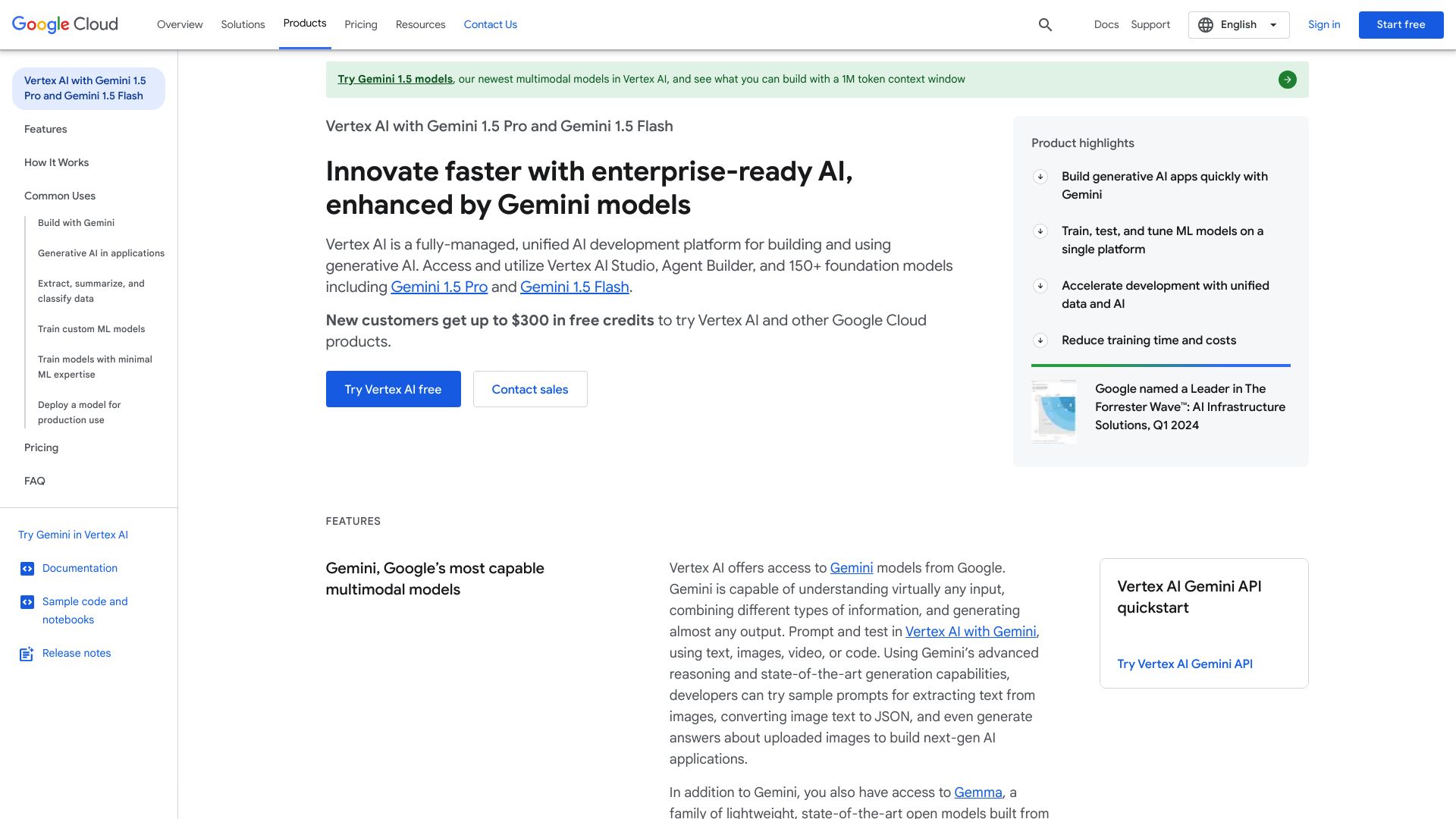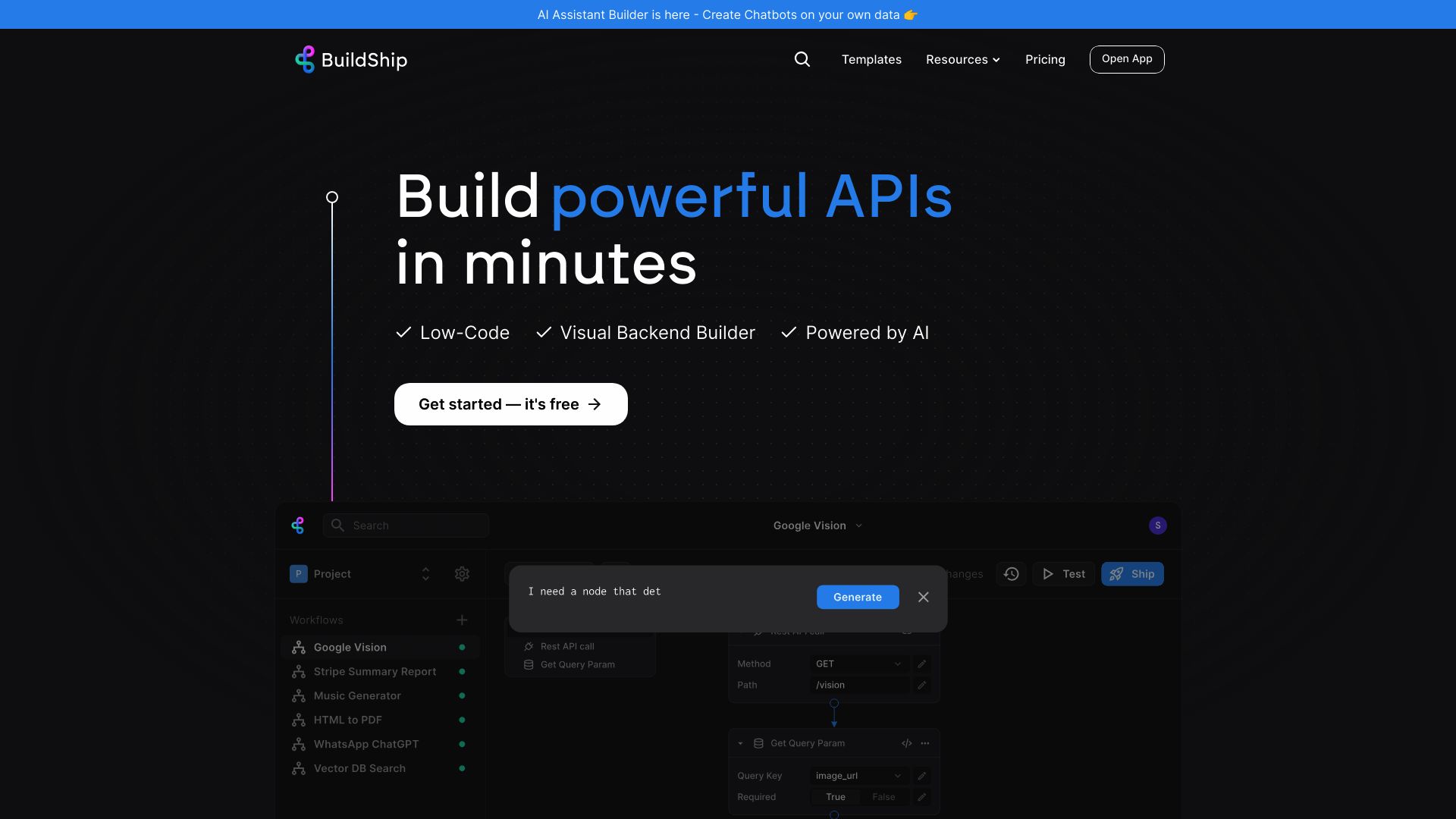Vertex AI vs. BuildShip: Comparing AI Development Platforms
Artificial intelligence transforms business operations daily, but choosing the right AI platform can overwhelm even seasoned professionals. This review compares Vertex AI vs. BuildShip, and SmythOS, three leading AI development platforms. We examine each platform’s strengths, limitations, and ideal use cases to help you select the best fit for your organization’s AI initiatives. Whether you’re a developer seeking advanced capabilities, a business leader focused on scalability, or a non-technical user looking for accessible AI tools, this comparison provides insights to guide your decision-making process.
Vertex AI Overview
Vertex AI transforms machine learning development with a comprehensive platform for training, deploying, and managing AI models at scale. Google Cloud’s offering unifies the ML workflow, empowering data scientists and developers to build production-ready AI applications efficiently.
The platform excels in handling complex AI tasks, supporting multimodal inputs including text, images, audio, and video. Vertex AI’s Gemini models, developed by Google DeepMind, showcase advanced reasoning capabilities, multiturn chat functionality, and code generation features. These powerful tools cater to enterprises seeking sophisticated AI solutions for tasks ranging from natural language processing to computer vision.
Vertex AI transforms machine learning development with a comprehensive platform for training, deploying, and managing AI models at scale.


Vertex AI streamlines the AI development process with features like Model Garden, which offers a library of pre-trained models for quick deployment and customization. The platform’s model registry and feature store facilitate efficient management of ML assets, while MLOps tools ensure smooth monitoring and orchestration of AI workflows.
Vertex AI streamlines the AI development process with features like Model Garden, which offers a library of pre-trained models for quick deployment and customization.
While Vertex AI provides robust capabilities, it requires significant coding knowledge, potentially limiting accessibility for non-technical users. The platform’s complexity may present a steep learning curve for some organizations. However, for teams with strong technical expertise, Vertex AI offers unparalleled flexibility and power in building custom AI solutions.
Vertex AI integrates seamlessly with Google Cloud’s ecosystem, enabling users to leverage BigQuery for data processing and Cloud Storage for model artifacts. This integration extends to external tools and APIs, allowing for the creation of sophisticated AI pipelines that can incorporate data from various sources and trigger actions across different systems.
BuildShip Overview
BuildShip empowers users to create, test, and deploy backend workflows and APIs without extensive coding knowledge. The platform’s visual no-code interface streamlines the development process, allowing teams to build complex automations rapidly.
BuildShip’s drag-and-drop workflow builder incorporates prebuilt nodes and AI-generated custom nodes, enabling seamless integration of various data sources, APIs, and AI models. Users can write custom logic in JavaScript or TypeScript when needed, providing flexibility for more advanced requirements. The platform’s testing capabilities allow for iterative development, with options to test individual nodes or entire workflows before deployment.
BuildShip empowers users to create, test, and deploy backend workflows and APIs without extensive coding knowledge. The platform’s visual no-code interface streamlines the development process…


Key features of BuildShip include AI-powered autofill for inputs using natural language prompts, a template library to accelerate development, and secure storage for API keys and secrets. The platform also offers OAuth integration for simplified service connections and robust deployment options, allowing workflows to be exposed as production-grade APIs or scheduled to run automatically.
While BuildShip excels in visual workflow creation and AI-assisted development, it may have limitations for users requiring extensive customization or specific integrations not covered by its prebuilt nodes. The platform’s focus on backend workflows and APIs may also make it less suitable for projects requiring advanced front-end development or complex user interfaces.
BuildShip positions itself as a tool for accelerating backend development and automation, aiming to make these processes ten times faster without sacrificing flexibility or power. Its combination of visual tools, AI assistance, and deployment options makes it a compelling choice for teams looking to streamline their workflow creation and API development processes.
Feature Comparison
Vertex AI and BuildShip offer contrasting approaches to AI development and deployment. Vertex AI provides a comprehensive machine learning platform with advanced capabilities, while BuildShip focuses on simplifying backend workflow creation.
Vertex AI excels in its breadth of AI tools and integration with Google Cloud services. It supports sophisticated model development, including multimodal AI like Gemini, and offers robust MLOps features. However, Vertex AI requires significant technical expertise, potentially limiting accessibility for non-developers.
BuildShip, conversely, emphasizes ease of use with its visual no-code interface. It enables rapid creation of backend workflows and APIs without extensive coding knowledge. BuildShip’s AI-assisted development and prebuilt integrations accelerate the process of connecting various services and data sources. Yet, it may lack the depth of customization and advanced AI capabilities found in Vertex AI.
In terms of security, both platforms offer data encryption and OAuth support. Vertex AI provides more granular controls with IP restrictions and extensive compliance features, critical for enterprise deployments. BuildShip’s approach to security, while solid, may not match Vertex AI’s enterprise-grade offerings.
We’ve designed SmythOS to combine the strengths of both approaches. Our platform offers the power and flexibility of Vertex AI with the user-friendliness of BuildShip. SmythOS provides advanced AI capabilities, including multimodal support and autonomous agents, while maintaining an intuitive visual interface. Unlike Vertex AI, SmythOS requires no coding knowledge, democratizing AI development. And unlike BuildShip, we offer deeper customization options and more sophisticated AI tools, bridging the gap between simplicity and power.
Feature Comparison Table
| Vertex AI | BuildShip | SmythOS | |
|---|---|---|---|
| CORE FEATURES | |||
| No-Code Options | ❌ | ✅ | ✅ |
| Memory & Context | ✅ | ❌ | ✅ |
| Autonomous Agents | ✅ | ❌ | ✅ |
| Explainability & Transparency | ✅ | ❌ | ✅ |
| Multimodal | ✅ | ❌ | ✅ |
| Problem-Solving Capabilities | ✅ | ❌ | ✅ |
| Multi-Agent Collaboration | ✅ | ❌ | ✅ |
| Human-AI Interaction | ✅ | ❌ | ✅ |
| Audit Logs for Analytics | ❌ | ❌ | ✅ |
| Work as Team | ✅ | ❌ | ✅ |
| SECURITY | |||
| Constrained Alignment | ✅ | ❌ | ✅ |
| COMPONENTS | |||
| Foundation AIs | ✅ | ❌ | ✅ |
| Huggingface AIs | ❌ | ❌ | ✅ |
| Zapier APIs | ❌ | ❌ | ✅ |
| Classifiers | ✅ | ❌ | ✅ |
| Data Lakes | ✅ | ❌ | ✅ |
| DEPLOYMENT OPTIONS (EMBODIMENTS) | |||
| Staging Domains | ✅ | ❌ | ✅ |
| Production Domains | ✅ | ❌ | ✅ |
| Deploy as Site Chat | ✅ | ❌ | ✅ |
| Deploy as GPT | ✅ | ❌ | ✅ |
| DATA LAKE SUPPORT | |||
| Hosted Vector Database | ✅ | ❌ | ✅ |
| Sitemap Crawler | ❌ | ❌ | ✅ |
| YouTube Transcript Crawler | ❌ | ❌ | ✅ |
| URL Crawler | ✅ | ❌ | ✅ |
| PDF Support | ✅ | ❌ | ✅ |
| Word File Support | ✅ | ❌ | ✅ |
| TXT File Support | ✅ | ❌ | ✅ |
Best Alternative to Vertex AI and BuildShip
SmythOS stands out as the superior alternative to Vertex AI and BuildShip for AI agent development and deployment. We combine advanced AI capabilities with user-friendly design, offering a platform that excels in both power and accessibility.
Unlike Vertex AI’s steep learning curve, our intuitive drag-and-drop interface allows users to create sophisticated AI workflows without extensive coding knowledge. We provide the depth of customization and AI tools Vertex AI offers, while maintaining the ease of use BuildShip emphasizes.
Unlike Vertex AI’s steep learning curve, our intuitive drag-and-drop interface allows users to create sophisticated AI workflows without extensive coding knowledge.
Our platform supports a wide array of AI models, including those from OpenAI, Anthropic, and Hugging Face, surpassing BuildShip’s limited AI integration options. SmythOS enables the creation of autonomous, multimodal agents capable of complex problem-solving and collaboration — features lacking in BuildShip’s simpler workflow automation tools.
We excel in deployment flexibility, allowing users to integrate AI agents seamlessly across various platforms and as APIs, chatbots, or scheduled tasks. This versatility outshines both Vertex AI’s Google Cloud focus and BuildShip’s more limited deployment options.
SmythOS delivers enterprise-grade security and scalability alongside its user-friendly interface, making advanced AI accessible to users of all technical backgrounds. By combining power, flexibility, and ease of use, we offer a comprehensive solution that bridges the gap between Vertex AI’s complexity and BuildShip’s simplicity, making us the ideal choice for organizations seeking to harness the full potential of AI technology.
Conclusion
Vertex AI, BuildShip, and SmythOS each offer unique approaches to AI development and deployment. Vertex AI provides a comprehensive machine learning platform with advanced capabilities, ideal for organizations with strong technical expertise. BuildShip simplifies backend workflow creation with its visual no-code interface, making it accessible to a broader audience. However, SmythOS emerges as the superior choice, combining the strengths of both platforms while addressing their limitations.
SmythOS stands out with its intuitive drag-and-drop interface, extensive integration ecosystem, and support for various AI models. Unlike Vertex AI, SmythOS requires no coding knowledge, democratizing AI development across organizations. It surpasses BuildShip’s capabilities by offering deeper customization options and more sophisticated AI tools, including multimodal support and autonomous agents.
Our platform’s versatility shines through its deployment options, allowing users to create AI solutions once and deploy them across multiple channels. This ’Create Once, Deploy Anywhere’ approach, combined with features like multi-agent collaboration and advanced security measures, positions SmythOS as the ideal choice for businesses seeking to harness the full potential of AI.
Ready to experience the future of AI development? Explore our diverse range of AI-powered agent templates to jumpstart your projects. For those eager to dive in, create a free SmythOS account and start building unlimited AI agents at no cost. Join us in revolutionizing workflows and unlocking unprecedented levels of automation and efficiency with SmythOS.
Last updated:
Disclaimer: The information presented in this article is for general informational purposes only and is provided as is. While we strive to keep the content up-to-date and accurate, we make no representations or warranties of any kind, express or implied, about the completeness, accuracy, reliability, suitability, or availability of the information contained in this article.
Any reliance you place on such information is strictly at your own risk. We reserve the right to make additions, deletions, or modifications to the contents of this article at any time without prior notice.
In no event will we be liable for any loss or damage including without limitation, indirect or consequential loss or damage, or any loss or damage whatsoever arising from loss of data, profits, or any other loss not specified herein arising out of, or in connection with, the use of this article.
Despite our best efforts, this article may contain oversights, errors, or omissions. If you notice any inaccuracies or have concerns about the content, please report them through our content feedback form. Your input helps us maintain the quality and reliability of our information.
